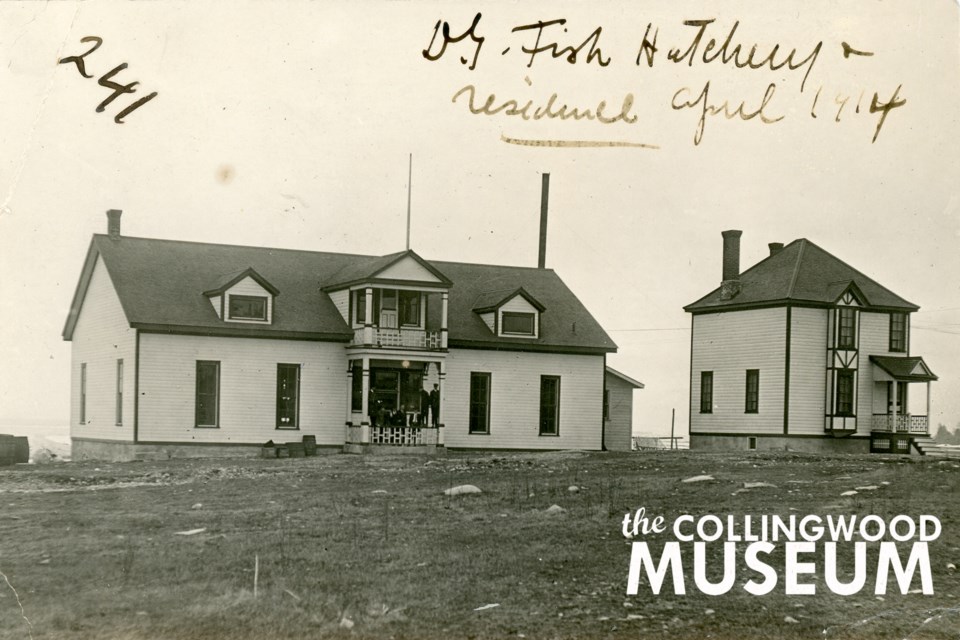This ongoing series showcases historic photos in the Collingwood Museum collection, with research and writing by Melissa Shaw, the museum supervisor.
As early as 1894, the federal government is recorded to have issued a report recommending that the size and quantity of nets used by commercial fishermen be limited due to declining fish stocks.
This proposal was controversial in early Collingwood as it threatened the livelihood of local fishermen and those who built their trade around the fishing industry.
The 1894 annual report from the Collingwood Board of Trade states that “…owing in a great measure to the prompt and energetic action of this board,…the destructive order was withdrawn, and the fishing industry….has been preserved.”
Although the government’s plan was never implemented, it did sponsor the construction of a local fish hatchery in 1912 at the north end of Raglan Street in today’s Sunset Point. Here, various species were spawned and raised in ponds, then released to streams and lakes around the province for more than 45 years.
In the 46th annual report from the Department of Marine and Fisheries for 1912-1913, the investment for Collingwood’s hatchery was $691.66 in salaries, and $13,235.18 in maintenance, the equivalent of approximately $370,600 in 2023.
For many years, the fish hatchery was a popular location for local families and visitors to Collingwood.
In Reflections: Collingwood, An Historical Anthology, former Collingwood resident Seward W. Herrington recalls: “When I was a kid, it was an interesting place to visit with your family on a Sunday afternoon and see the fish eggs in rows of large bottles, about three feet high, with water running into them. This would keep the eggs moving within these jars. Weeks later on visiting the hatchery, you could see the little minnows…” (p. 167).
According to the provincial government’s website, Collingwood’s hatchery was transferred to the province in 1926. Hatcheries in Wiarton, Sarnia, Port Arthur, Southampton, Belleville, Kenora, and Kingsville were also transferred in the same year.
In 1950, the local chapter of the Order of the Eastern Star issued the Know Collingwood publication that highlights Collingwood’s businesses and attractions. A small section, including a photograph, features the following description of Collingwood’s hatchery:
“The Ontario Government Fish Hatchery is situated at the easterly end of Callary Park near the limits of Collingwood. Spawn from both game and commercial fish are secured from the natural spawning beds and are hatched under carefully controlled conditions. Fingerlings and larger fish of whitefish, trout, bass, pickerel, etc. are released in the streams, ponds and lakes of Ontario at carefully selected times. This re-stocking ensures good fishing for both sportsmen and commercial fishermen. Visitors to the fish hatchery will learn many interesting things about fish.”
Thanks to the records of the Collingwood Museum’s predecessor, the Huron Institute, the names and years of service of the hatchery’s superintendents have been preserved: Matthew Clark 1912-1915, J.E. Turner 1915-1936. George Andrews assumed the superintendent position in 1936 and was still in this position in 1939 when the Huron Institute’s Papers and Records: Volume III Historical Catalogue was published.
The Marmoa Historical Society records that John “Jock” Hunt worked at Colingwood’s hatchery until its closure in the late 1950s. He was then hired as manager of the Deer Lake Hatchery where he served in this position until 1974.
The Georgian Triangle Anglers' Association started a fish hatchery in 1985 on the bank of Black Ash Creek on Blue Mountain in what is now the Petun Conservation Area. Volunteers continue to run the hatchery that houses between 90,000 and 100,000 fish in various stages of growth. About 70 per cent of those fish, which include rainbow, brook and brown trout, survive and are released into local waterways.
If you remember visiting our local hatchery or have any information to share about family members who worked there, we would love to hear from you.



